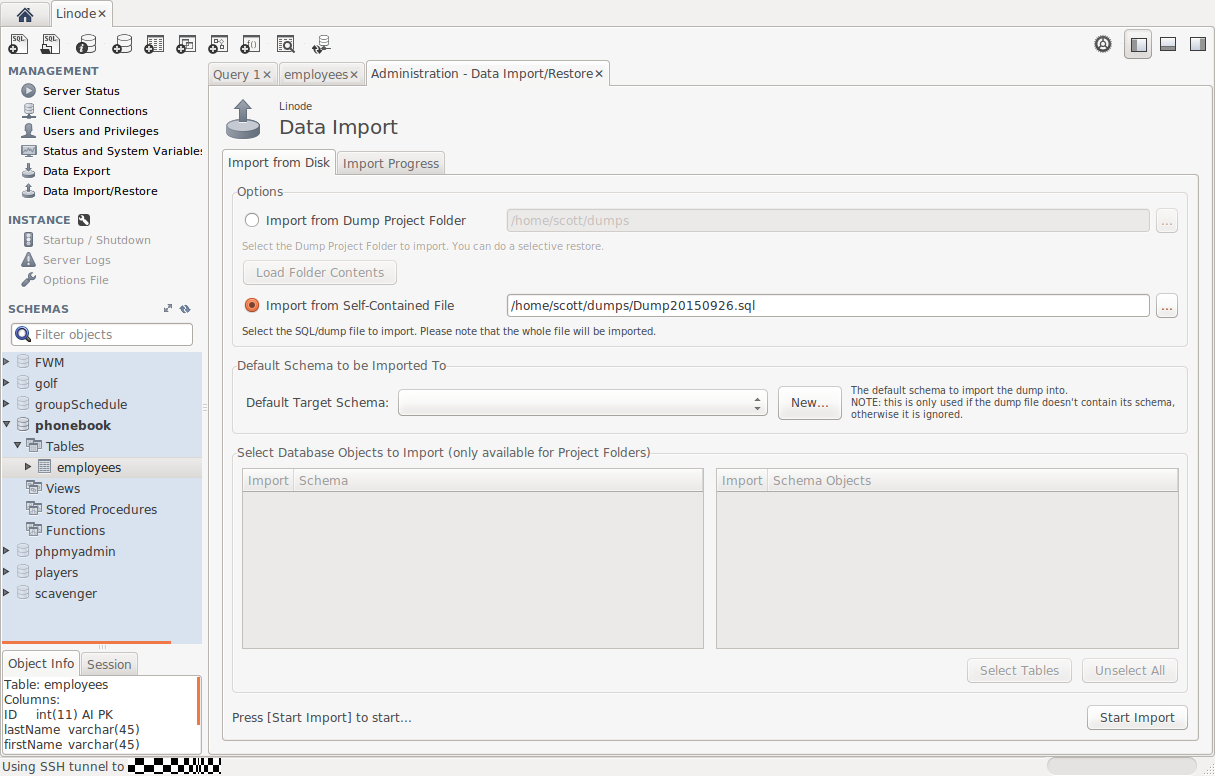

- #MYSQL WORKBENCH IMPORT DATABASE HOW TO#
- #MYSQL WORKBENCH IMPORT DATABASE UPDATE#
If you are connected to the database, Choose Backup… from the File menu.If you are in the welcome screen, click on the backup icon.Choose the destination folder to store the exported file from the dialog box.Īnd now your tables are exported on your destination folder.You can also easily import previously created.
#MYSQL WORKBENCH IMPORT DATABASE HOW TO#
Choose to include table content or structure, or drop table if exists command in the Dump file. Examine how to create server instance in desktop MySQL/MariaDB client and dump database to the local file.This will bring up a dialog box where you can choose output data. To export an SQL dump file of the table structure or contents: How do I save the table structure/table content as an SQL Dump file? This will bring up a dialog box, select the file on your file system, then click Start Restore.Choose connection and database to backup, or add any options if you want.If you are connected to the database, Choose File > Restore… from the menu.If you are in the welcome screen, click on the restore icon.

It uses the binaries of the database for the job, and it’s compatible with the latest version of MySQL. Your database will now be updated. Click the Refresh button (Cmd + R) if needed.This will bring up a dialog box, select the file on your file system that you would like to import, then click Import.If any errors occur during the process, MySQL will display them on the terminal. Export schema structure using MySQL Workbench From the Server menu, choose Data Export On the left side, choose the database to export. Choose Import > From SQL Dump… from the File menu. file.sql: the SQL file to import, located in the current directory If the command is executed successfully, it will not produce any output.
 Careful: Importing a *.sql file may overwrite your existing data!.
Careful: Importing a *.sql file may overwrite your existing data!. #MYSQL WORKBENCH IMPORT DATABASE UPDATE#
You have to update the app to the latest version to make sure the app runs properly. Now TablePlus has already supported Import SQL Dump. It works just fine for the small sized file, but for a huge file, it gives the app a hard time executing it. Previously, you can import and *.sql file to use with your database in TablePlus by dragging the file into the query editor and execute it. You can now export your model in the regular way as any other Skipper project.How do I import an SQL Dump file into MySQL database? Once the model is imported from MySQL Workbench to Skipper, you can easily export it to ORM framework you have defined during import (Doctrine, Doctrine2, Propel or CakePHP). Skipper will automatically prepare set of ORM specific properties for each element, and you only need to choose which will be used to fully benefit from the ORM approach. The tables, columns, relations and properties defined in the model will become entities, fields and associations for your ORM schema. You can verify if the database has been imported by logging back into the MySQL shell and inspecting the data. If any errors occur during the process, MySQL will display them on the terminal. Your database schema will now be converted to ORM model. file.sql: the SQL file to import, located in the current directory If the command is executed successfully, it will not produce any output. What ORM Framework and MVC Framework do you want to use for the exported schema. What application are you importing from (in this case MySQL Workbench). This launches wizard which will guide you through the necessary options like: / Export or Import a Table 8.1.9 Export or Import a Table Export or import tables using a wizard to assist you. To import MySQL Workbench model to Skipper open the Skipper Main Menu, select Create or import new and then select Import external model. All that you need to do is just save your model the usual way in MySQL Workbench, and everything else will be taken care of by Skipper. Main focus of this comparison lies in the ORM framework support and ORM oriented design. Read the comparison study if you are more interested about differences between the Skipper and MySQL Workbench.







 0 kommentar(er)
0 kommentar(er)
